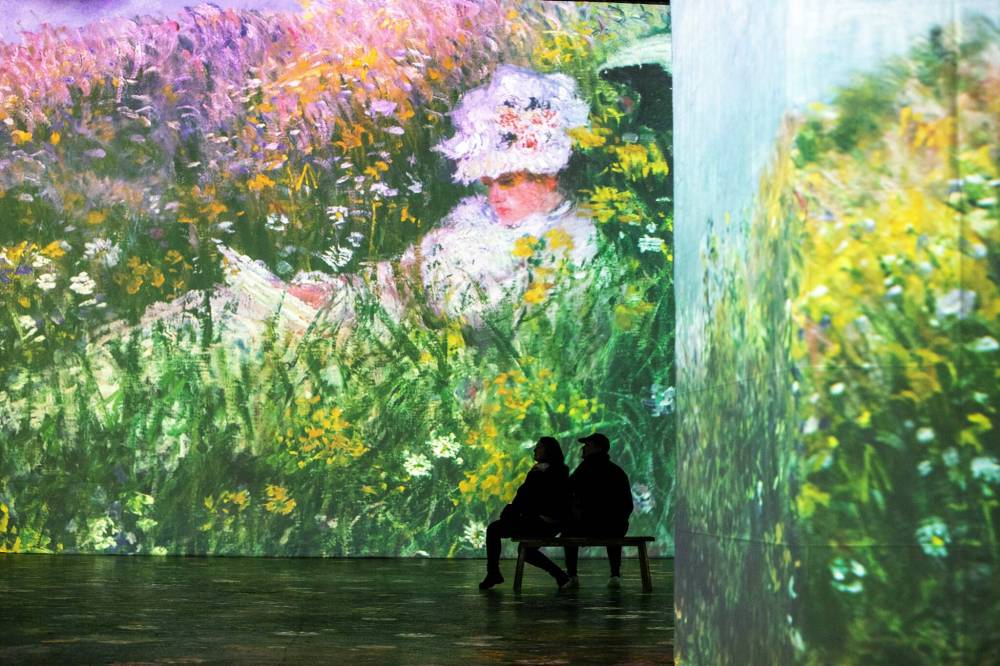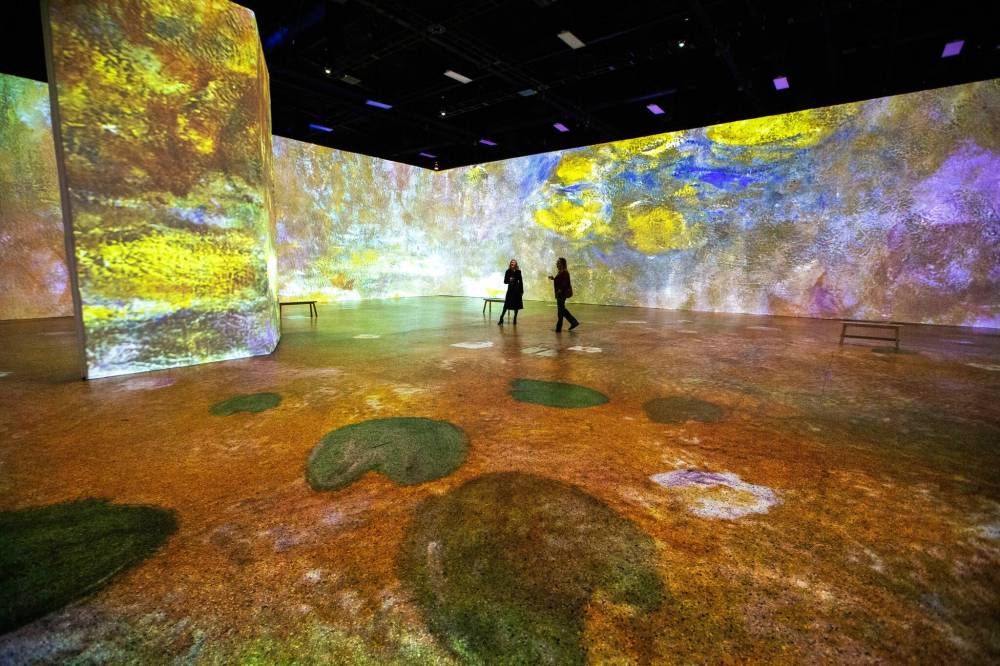Take it all in Art needs time to be viewed, not consumed
Read this article for free:
or
Already have an account? Log in here »
To continue reading, please subscribe:
Monthly Digital Subscription
$0 for the first 4 weeks*
- Enjoy unlimited reading on winnipegfreepress.com
- Read the E-Edition, our digital replica newspaper
- Access News Break, our award-winning app
- Play interactive puzzles
*No charge for 4 weeks then price increases to the regular rate of $19.00 plus GST every four weeks. Offer available to new and qualified returning subscribers only. Cancel any time.
Monthly Digital Subscription
$4.75/week*
- Enjoy unlimited reading on winnipegfreepress.com
- Read the E-Edition, our digital replica newspaper
- Access News Break, our award-winning app
- Play interactive puzzles
*Billed as $19 plus GST every four weeks. Cancel any time.
To continue reading, please subscribe:
Add Free Press access to your Brandon Sun subscription for only an additional
$1 for the first 4 weeks*
*Your next subscription payment will increase by $1.00 and you will be charged $16.99 plus GST for four weeks. After four weeks, your payment will increase to $23.99 plus GST every four weeks.
Read unlimited articles for free today:
or
Already have an account? Log in here »
Hey there, time traveller!
This article was published 01/12/2023 (745 days ago), so information in it may no longer be current.
There is a particularly gutting scene in John Hughes’ 1986 coming-of-age classic Ferris Bueller’s Day Off in which Ferris’s best friend Cameron has an existential crisis in an art museum.
The teens have, rather wholesomely, included the Art Institute of Chicago in their hooky-playing plans and Cameron (Alan Ruck) is lost in Georges Seurat’s 1884 pointillist masterwork A Sunday on La Grande Jatte. The scene is set to a synthy, dreamy instrumental version of the Smith’s Please, Please, Please Let Me Get What I Want and cuts back and forth between Cameron’s increasingly troubled face and that of a child in the painting, punching in closer and closer each time until the child’s face dissolves into a blur of dots.
“The closer he looks at the child, the less he sees, of course, with this style of painting,” Hughes said of that scene. “But the more he looks at it, there’s nothing there. He fears that the more you look at him, the less you see. There isn’t anything there. That’s him.” (As I said, it’s gutting.)

MIKAELA MACKENZIE / WINNIPEG FREE PRESS
Pam Hardman (left) and Alyssa Ducharme enjoy Thursday's VIP preview of Beyond Monet: The Immersive Experience, a touring exhibition now at the RBC Convention Centre that puts you inside Monet’s ethereal impressionist works.
I kept thinking about Cameron and the Seurat at Beyond Monet: The Immersive Experience, a splashy touring exhibition on view now at the RBC Convention Centre that, essentially, puts you inside the French painter’s ethereal impressionist works.
Viewers are surrounded by 400 video projections of the painter’s works, high-resolution images pulled from museum collections around the world. And by surrounded, I mean in every sense: the walls and floors are covered with images that move, and an aural component — whether crashing waves or chirping birds — adds to the immersive effect.
The exhibition is cool, certainly, and it’s easy to lose yourself in it provided you ignore the siren song of documenting it all on your phone.
These works are not bound by a frame, nor are you required to wander a space (or travel a great distance) to find them.
But art, as John Hughes so poignantly showed us with Cameron, always has the power to be immersive, if you give it time to be.
Fanny Curtat, a Montreal art historian and consultant for Beyond Monet, shared a stunning stat with my colleague Alan Small: on average, people tend to stay 10 to 13 seconds in front of any artwork in a museum.
I have a few theories as to why that might be: crowds in front of the famous ones; reproduction fatigue (it’s hard to muster enthusiasm about an image you’ve seen replicated thousands of times on college dorm-room walls); and perhaps stress about not knowing “how” to look at art, which is usually bound up with anxiety about “getting it.”
I include myself in this camp too, lest you think I’m over here polishing my monocle. Looking at art isn’t just about techniques and art movements and history. It’s about how it makes you feel when you look at it.
How we view art (or don’t) could be a byproduct of our increasingly fast society. Fast fashion. Fast food. Fast art. We consume art, rather than view it.
There’s actually a global movement aimed at combating this drive-by style of interacting with art: Slow Art Day, which takes place every April. The premise is simple: choose a work that speaks to you and spend, at minimum, 10 minutes looking at it.

MIKAELA MACKENZIE / WINNIPEG FREE PRESS
In Beyond Monet, viewers are surrounded by 400 video projections of high-resolution images taken of the painter’s works.
I had a bit of a Cameron moment when I saw A Sunday on La Grande Jatte in person last year. It’s an unfathomable work, all those points of colour, making a massive whole. (Incidentally, I saw some of Monet’s beloved water lilies there, too.) That experience didn’t have the razzle dazzle of a multimedia presentation, but it didn’t need to, either.
Also, there are just some works you can’t help but spend a lot of time with. I was at the Denver Art Museum in October, and I had no idea that’s where Kent Monkman’s arresting 2017 work The Scream — a harrowing depiction of the removal of Indigenous children from their homes by Canadian Mounties — is located. I had no idea how large it is, either. When I turned around and saw it was there, I gasped. I couldn’t stop going back to it.
Slow Art Day wants people to slow down, but it also wants to make the practice of viewing art accessible, which is what popular immersive exhibits such as Beyond Monet and its predecessor Beyond Van Gogh also seek to do. Perhaps Beyond Monet will inspire people to go look — really look — at art in institutions they may have been intimidated by.
But Beyond Monet is also its own, new thing — a technology-rooted experiment in creating an art exhibition with no physical paintings. Which isn’t unlike what Hughes was doing 100 years after the fact with A Sunday on La Grande Jatte.
Consider the way that scene is initially framed up. It’s a wide shot. You have the painting, instantly recognizable even if you don’t know its title or the name of the artist. Cameron has his back to us, the blocky, bright red of his Red Wings jersey (No. 9, Gordie Howe, also iconic) juxtaposed against all those tiny dots of colour.
That’s a work of art, too.
jen.zoratt@winnipegfreepress.com

Jen Zoratti is a columnist and feature writer working in the Arts & Life department, as well as the author of the weekly newsletter NEXT. A National Newspaper Award finalist for arts and entertainment writing, Jen is a graduate of the Creative Communications program at RRC Polytech and was a music writer before joining the Free Press in 2013. Read more about Jen.
Every piece of reporting Jen produces is reviewed by an editing team before it is posted online or published in print – part of the Free Press‘s tradition, since 1872, of producing reliable independent journalism. Read more about Free Press’s history and mandate, and learn how our newsroom operates.
Our newsroom depends on a growing audience of readers to power our journalism. If you are not a paid reader, please consider becoming a subscriber.
Our newsroom depends on its audience of readers to power our journalism. Thank you for your support.

